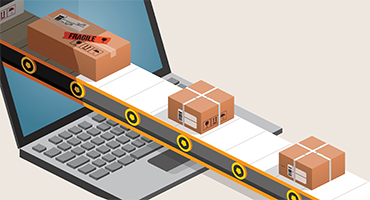Tightening the chain
November 26, 2019Retailers in Canada continue on their quest toward creating elusive last mile efficiency
CANADIAN eCommerce sales continue to grow. That’s naturally promising for Canadian online merchants. But it also means that retailers across the country must develop their supply chain logistics to more efficiently manage changing customer expectations and the demands of our vast country. It’s a daunting challenge, and it’s being done in the shadow cast by Amazon’s industry-shaping policies.
Retail supply chain logistics is concerned with the flow of purchased goods and materials inbound to the business, and the outbound flow of goods that have been sold to customers. All logistics represent a large investment in dollars and human capital for retailers, but outbound logistics (the so-called ‘Last Mile’) are of particular importance to the retail industry as this is the part of the chain that directly impacts, and can be seen by, the end consumer. The cost and efficiency of outbound logistics—the sale and shipment of purchased goods to customers—has a major influence on how well retailers service their customers, how effectively they compete in their markets, and how well they perform from a financial perspective.
This, for obvious reason, is particularly true of retailers whose business is solely or principally eCommerce driven, not an inconsiderable industry niche here in Canada. In 2017, online purchases accounted for 7.8 per cent of all Canadian retail sales, according to eMarketer Inc. research. But by 2020, that number is expected to hit 10 per cent, with a value of more than C$55bn. As a consequence, a significant part of retail industry fortunes is dependent on finding a cost effective and efficient manner of managing outbound logistics.
And it’s something they need to figure out quikkly, because evidence suggests that Canadian retailers are failing to keep pace with the market. The U.S. International Trade Administration reported that a full one-third of Canadian eCommerce dollars are going to U.S.-based retailers.
Much of Canadian retail’s struggle to keep pace is due to something Charles-Antoine Marcil, Project Manager at GCL Group, calls ‘The Amazon Effect’, a reference to the ubiquitous American eCommerce colossus, Amazon.
“The Amazon model has disrupted the industry by radically altering consumer expectations,” he explains. “They offer extremely low—if not free, in the case of Amazon Prime—delivery fees, next day deliveries, and quick returns that just a few years ago were unheard of and which is proving problematic for many retailers to keep pace with. Their model is transforming the landscape and Canadian e-retailers are being forced to find ways to keep pace.”
Reg Adams, Vice-President of Techdinamics Integrations Inc., agrees. “With consumer expectations rising by the day, with a demand for increased visibility and speed of their parcels, eCommerce businesses have to up their game by making every effort to increase efficiency and minimize cost of delivery,” he asserts. “They have to leverage every advantage to keep pace with the new reality of consumer expectations and to offset difficulties inherent to operating in Canada.”
“The Amazon model has disrupted the industry by radically altering consumer expectations… Their model is transforming the landscape and Canadian e-retailers are being forced to find ways to keep pace.”
CHARLES-ANTOINE MARCIL
GCL Group
When asked, most eCommerce retailers will readily offer that the high costs of parcel delivery in Canada represent a big problem for them to deliver against rising expectations. “Transportation costs are inevitably higher in Canada because of the size of the country and because its population is clustered in widely dispersed population centres,” Marcil explains. “Most large retailers will have distribution centres (DCs) in Toronto, Montreal and somewhere out west (Vancouver or Calgary). But that still leaves a lot of country to cover. And what of smaller retailers that may only have one DC? The size of the country and the resultant high cost of shipping are problematic for eCommerce in Canada.”
Many retailers face the conundrum of passing on the full cost of shipment to their customer, which in all likelihood means they won’t make the sale, or assume the cost of shipping themselves, thereby eating into their profit margin. This effectively limits a retailer’s effective sales territory and their potential for future growth.
And it’s not just price. Most eCommerce retailers offer a range of delivery times at different costs, with faster deliveries naturally being most expensive. Actual delivery time typically depends on how far the customer needs the order shipped. Larger companies can afford to expedite services which result in shorter delivery times as their standard offering, even when they do not charge the customer for delivery. This is considered a lossleader; accepting a loss in the name of adding value for their customers as part of their growth strategy. Most Canadian e-retailers don’t have that luxury, however.
Another logistics challenge bedeviling eretailers in Canada involves the vexing matter of returns. eCommerce retailers experience a rate of returns greater than that experienced by brick and mortar retailers. Indeed, it could be as high as one-third of all sales. “Returns are the Achilles heel of eCommerce,” says Adams. “It’s not enough to focus on delivering the goods to customers. Ensuring a smooth, easy returns process is essential to any eCommerce retail business strategy. E-retailers are finding it hard to manage expectations from a cost standpoint because consumers expect to return purchases at little or no cost. Consumers also expect that the returns process will be simple and result in the quick resolution of the return. It’s something e-retailers need to consider when planning for their logistics needs.”
Canadian retailers involved in eCommerce are exploring innovative ways to overcome logistics challenges.
“It’s all about information systems when it comes to cutting costs and speeding up last mile deliveries. Everything from order confirmation to verification to shipping cost calculations has to be automated through information systems to achieve the greatest possible efficiencies.”
REG ADAMS
Techdinamics Integrations Inc
Ship to and from Store
Retailers find it hard to compete with Amazon’s cut-rate delivery rates. To compete, many—Chapters/Indigo immediately jumps to mind—are offering ship free-to-store options on online orders. They can economically do this because these items are generally shipped as part of a larger consolidated shipment, which is far less expensive than shipping to a home.
Some retailers are even shipping from stores. “We’re seeing many retail chains investing in shipping items more efficiently from stores nearest the customer, as opposed to regional DCs,” explains Adams. “Giant Tiger, for example, started to fulfill orders from stores that had items in-stock and are closer to the customer. But to do this, you need real-time data on your inventory, both what’s in-hand and what’s coming.”
Marcil agrees there is potential in the ship-from-store model, but notes there are other challenges as well. “Shipping from stores is rising in popularity, but it can be challenging from a staffing stand-point. Employees are paid to do sales, but when you are doing shipments, they are not on the floor serving customers.”
3PL
Many companies are turning to third-party logistics (3PL)—the use of a third-party business to outsource elements of distribution, warehousing, and fulfillment services. The 3PL industry has grown rapidly in recent years as eCommerce retailers lean on the experience and infrastructure of outsourced partners rather than trying to build them up themselves, at great expense in time and money. It’s a tempting option as companies can gain a competitive advantage by having highly efficient and, as a result, lower cost logistics. They can in turn lower logistics costs into better pricing for their customers.
“There are advantages to 3PL, and as a result a lot of retailers are wondering if they should outsource last mile logistics or do it themselves,” says Marcil. “The trick is to truly understand your options and costs, to have a strategic vision and know what you want to achieve. Only then can you see if it’s worth doing it yourself or through 3PL, because there are extra costs associated with 3PL.”
Technology
“It’s all about information systems when it comes to cutting costs and speeding up last mile deliveries,” opines Adams. “Everything from order confirmation to verification to shipping cost calculations has to be automated through information systems to achieve the greatest possible efficiencies.”
Increasingly, this means the use of WMS technology in warehouses to ensure visibility, proper inventory management, and quality control. Automated picking of eCommerce orders ensures greater efficiency. At the same time, eCommerce companies are turning to courier software to match Amazon’s delivery performance.
“Courier software is being leveraged to achieve more efficient last mile delivery,” Adams explains. “Access to real time information, including tracking of shipments, orders and inventory management, is crucial to the success of eCommerce logistics efforts. For example, mobile enabled software can automatically optimize the route which drivers should follow, even updating to compensate for unexpected situations that can affect delivery, the end result of which is a faster delivery. Courier service software keeps managers and customers updated regarding delivery progress in real time.”
Innovative Warehousing
Keeping warehouse and freight costs down is a vital part of making sure that e-retailers can affordably ship to consumers. “The majority of eCommerce sales are made near large urban centres. But the cost of warehousing and low vacancy rates in these same centres— key to being able to fulfill the one day delivery promise—is so high as to be prohibitive to most medium and small-sized retailers,” says Marcil. However, there are a number of innovative ways in which retailers are addressing this.
One way that’s rising in popularity is the concept of ‘pop-up’ supply chains and warehouses, which sees companies acquiring space via short-term leases. At the heart of on-demand warehousing is a very simple concept: the system depends upon the successful match up of companies that have excess warehouse space with companies that have short-term excess inventory.
Pop-up supply chains enable companies to make a shorter-term financial commitment to a location for space and provide the benefit of enabling cost-effective response to seasonal demand spikes in addition to facilitating immediate fulfillment in highly populated zones. On-demand warehousing also helps companies save money by only paying for the space they actually use, enabling them to scale up or down as needed.
Another innovative idea that has taken hold is “micro warehousing”. Micro warehouses are small, non-traditional spaces used as ad-hoc fulfillment centres (anything from unused space in a business building to a personal garage) within a major population centre. These miniature distribution centers are used to house a limited selection of the most popular SKUs to help speed up eCommerce order fulfillment. Because warehouses are typically situated outside the city limits, using small spaces are advantageous to eCommerce retailers by bringing warehouses closer to the end consumer, shortening last mile delivery.
To compete with Amazon, and other eCommerce giants, in Canada’s unique geographic and economic environment, the country’s retailers are forced to adapt their supply chain logistics to be tighter to create greater efficiencies. Modern consumers have higher expectations of online vendors, but the prize—higher sales, greater penetration of the online retail market, and increased brand loyalty—are well worth the efforts being put into developing competitive ‘Last Mile’ practices.
BY ANDREW HIND




